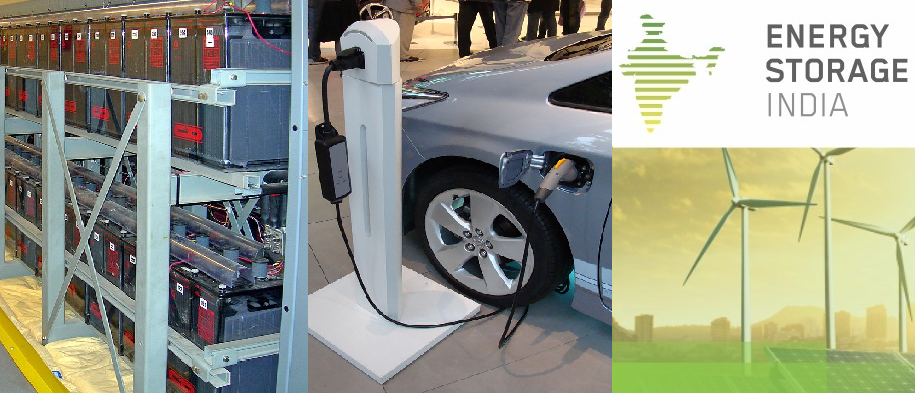Energy Storage India (ESI) 2018 was held in New Delhi from January 10-12. The exhibition and conference witnessed participation from 25 countries and attracted more than 2,000 industry experts, speakers, and delegates.
As part of the event, ESI organized short visits to ACME to showcase its battery swapping and charging stations for Electric Vehicles (EV). A small tour was also arranged to smart mini-grid systems and Tiger Power’s ‘Sunfold’ – Energy in a box project.
The exhibition organized a pre-conference workshop inaugurated by PC Pant, Director, MNRE, and Rahul Walawalkar, Executive Director, India Energy Storage Alliance (IESA). The workshop touched upon some interesting topics like Energy Storage 101 and 102, Economic analysis of Energy Storage Systems (ESS), and CoMETS.
Companies including Mahindra, Power All, Exicom Tele-Systems Ltd and ACME showcased their li-ion batteries while Kest Technology displayed its flywheel storage capabilities and PuNeng Energy exhibited emerging flow battery technology.
Additionally, the exhibition saw leading players such as Exide Industries, Microtex Batteries and Trojan Battery showcase their lead-acid and advanced lead-acid batteries. Sileaf Technology also launched its intelligence Battery Monitoring System (BMS) at the expo.
Addressing ESI 2018, Minister of Commerce & Industry, Suresh Prabhu said: “Energy storage can change the dynamics of the energy profile of the world, and thus energy storage is a critical component in the global energy strategy.” He encouraged participants to work together globally on R&D that particularly considers local needs.
Electric transportation was one of the hottest topics of the exhibition, even more so since the news that India is planning to go entirely electric from 2030. Addressing the future of Electric transit in India, RV Deshpande, Minister of Large and Medium Scale Industries and Infrastructure Development, Karnataka said: “The need is not just to boost the manufacturing of electric vehicles, but also manufacturing of batteries. Karnataka is the first state to release an electric vehicle and energy storage policy in India. We aim at making Karnataka and India the research hub for EV, and make Bangaluru the EV Capital of the country.”
To have a robust energy market in India and a defined path, NITI Aayog stated that it is in the process of formulating an India Energy Policy, of which energy storage will cover a significant portion.
One of the exciting session of the event was the rural microgrid session. The private microgrid organization like SELCO, The Energy and Resources Institute (TERI), and GHE (Global Himalayan Exhibition) exhibits its electrification expansion to million households in villages. Li-ion vs. lead acid is always a part of any energy storage discussion. Nitin Akhade from CLEAN mentioned that although the journey towards lithium-ion penetration has begun, the robustness of lead-acid technologies gives them a longevity advantage.
At the event, ACME Cleantech Solutions Pvt Ltd received the award for the Energy Storage Project of the Year category for Electric Vehicles , and EXICOM Tele Systems Ltd bagged the award in the Energy Storage Company of the Year category.
ESI 2018 also saw a major announcement by NLC (Neyveli Lignite Corporation – a coal mining company in India): the corporation is developing an 8 MWh energy storage project, with solar, for Andaman. Energy conglomerates like Delta, Exicom, and EnerBlu also shared their manufacturing plans for India’s storage market.
Robert Pedraza, Chief Strategy Officer at EnerBlu concluded: “India should consider investing in energy storage not just for energy security, but also for exporting to the Middle East, Africa, and Southeast Asia.” Delta has committed to expanding its R&D and manufacturing investments in India, while Exicom plans to deploy 1 GWh of energy storage solutions by the financial year 2018-19.
This content is protected by copyright and may not be reused. If you want to cooperate with us and would like to reuse some of our content, please contact: editors@pv-magazine.com.








“India is planning to go entirely electric from 2030. ”
Right……..and the power will come from where?
Through various energy source installation, mainly renewables, where India has planned 175GW by 2022. And there after, new plans will be expected. This capacity is just renewables, simultaneously thermal plants are keep on installing and if you are aware India has signed nuclear deals for new plants.
And for rural areas where there are still no grids, mini and micro grids are the solutions.
It is an ambitious task, but the important thing is ‘to plan’. A plan should be there, even if it is not fully achieved on time, because a blue print at least give a push to work.